How to temper chocolate and make your own Easter eggs
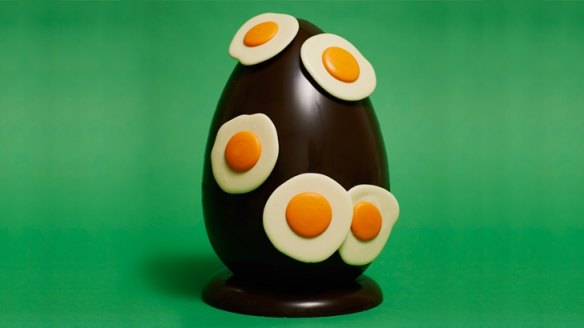
Even if you're not much of a baker, you've probably attempted a cake. But how many of us can say the same about chocolate? I'd wager that, regardless of how much of it you might eat, you've never even thought about making your own.
You should. As I recently discovered, making chocolate is actually quite simple. To be fair, it wasn't from cacao pods I'd hand-harvested. But through mastering a technique known as tempering, and under the guidance of Kirsten Tibballs from Savour Chocolate School in Melbourne's Brunswick, I was able to turn a few handfuls of chocolate buttons into a glossy Easter egg pretty easily.
If you watch MasterChef (on which Tibballs is a frequent guest) or any of the other cooking shows, you've likely heard about tempering. But what is it, and why do you need to do it?
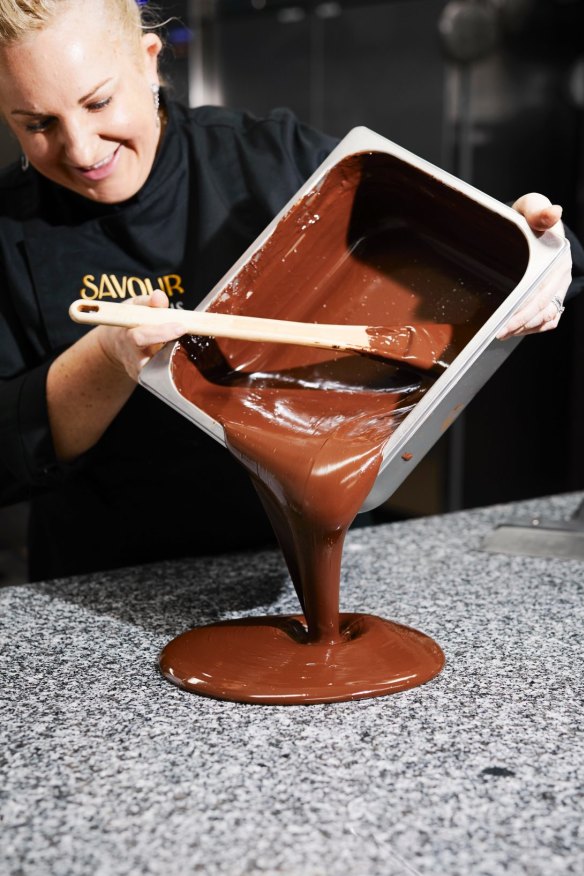
For any sort of chocolate work (except for when it's used as an ingredient, for example in baking) you need to melt it down to a workable consistency. But if you've ever accidentally left a Freddo Frog to melt on the dashboard of your car, you may have noticed that, after it had resolidified, the surface of it was covered in white, grainy crystals.
By controlling the melt – or tempering – you ensure the fatty acid crystals in the cocoa butter stay together in a stable form, leaving your chocolate not just workable but shiny and glossy, too. And the best bit? You can do it in a microwave.
Impress your friends and family this Easter with a homemade chocolate egg. It requires just a few ingredients and minimal equipment to make, most of which you likely already have, and all of which can be purchased online from Savour Chocolate School if you don't.
INGREDIENTS
Dark chocolate (we used Callebaut Dark Callets with 54.5 per cent cacao solids)
White chocolate (we used Callebaut White Couverture with 28 per cent cacao solids)
Orange oil-based colour powder (you must use an oil-based powder – liquid will cause the chocolate to seize)
EQUIPMENT
Easter egg mould
Piping bags (ziplock bags work fine)
Baking paper
Flat baking/oven trays
Plastic bowl
Spatula
Palette knife/scraper
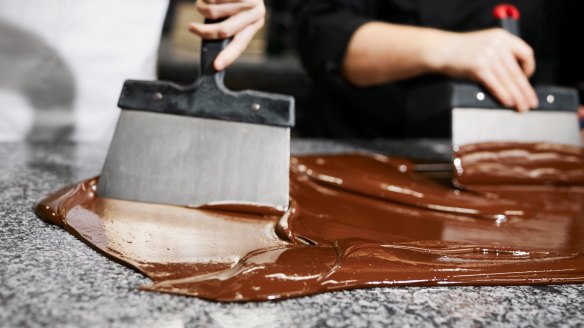
Step 1: Temper the chocolate
First, you need to melt the chocolate (how much chocolate you need will depend on the size of the egg you want to make). Using a plastic bowl, melt the chocolate in 30-second increments in your microwave until half the chocolate has melted to a liquid and the other half is still solid. Take it out of the microwave and vigorously stir it until all the chocolate has melted. If you have a few buttons that haven't melted, you can use a hair dryer to melt them rather than putting the bowl back in the microwave (you can use a hair dryer to warm the chocolate at any future stage). If using a microwave, you can now jump ahead to step 2.
If you don't have a microwave, you can use a double-boiler. Make sure the bowl (plastic or stainless steel) fits as snugly into the saucepan as possible to protect the chocolate, as you want to avoid any steam touching the chocolate (it could cause the chocolate to seize). Bring water in the bottom pot to a gentle boil and melt the chocolate, warming it until it reaches 45 degrees. Next, tip it on to a clean workbench, and spread it out. Scrape it back into the centre of your bench, then spread it out again. Repeat a few times until the temperature of the chocolate has been brought down to 27 degrees. Scrape it back into the bowl and stir until it's nice and smooth. Like the microwave method, you can use a hair dryer to smooth out any lumps.
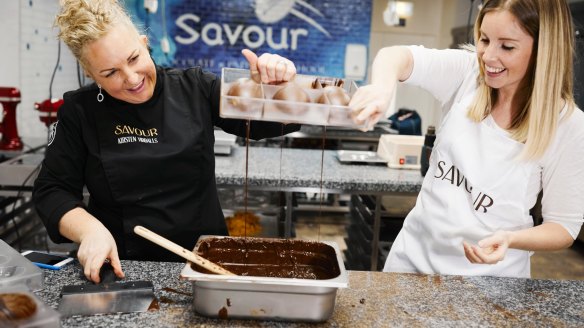
Step 2: Create the egg
Now, it's time to fill the moulds. Start by dipping your fingers into the tempered chocolate, and use them to create a thin layer of chocolate on the inside of the mould. The thinner the layer of chocolate, the faster it will set and the glossier it will be – this first step ensures your eggs are as shiny as possible. Leave that layer for a minute to set, then fill the moulds completely with chocolate. Scrape the top and sides of the mould with a palette knife or scraper (or the back of a regular – blunt! – knife) to get rid of any excess chocolate. Then, tap the base of the mould on the surface of the bench, rocking it from side to side, to push out any air bubbles. It's okay if you can see a few on the top – it's just important to dislodge them away from the edges and the surface. Now, tip the mould upside down evenly over the bowl so the chocolate runs out of it, scraping the surface as you do.
Set the mould face-side down over a sheet of baking paper and leave it for 10 minutes. Then, flip it over and scrape the surface of the mould again – the chocolate edges need to be completely flat otherwise they won't stick together. Place the mould in the fridge and leave to set for 20 minutes.
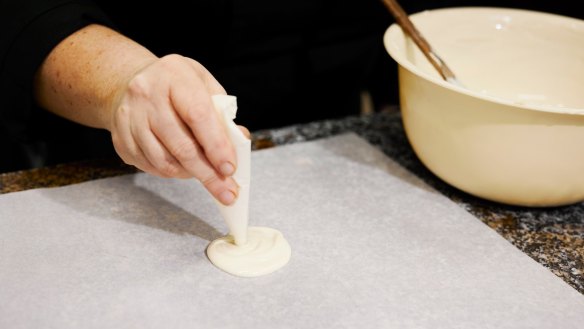
Step 3: Make the decorative chocolate fried eggs
To make the decorative chocolate fried eggs, temper white chocolate using the above method. Split it into two batches, and add a small amount of the orange oil-based colour powder (you must use an oil-based powder – liquid will cause the chocolate to seize) to one of the batches until it reaches the desired yolk colour.
Lay a sheet of baking paper over a cold, flat baking tray (or similar). Roll a sheet of baking paper into a cone or half-fill a ziplock bag with the tempered white chocolate, seal the bag and twist the top, directing the chocolate into one corner. Cut the tip off the corner and pipe the white chocolate into a fried egg-shape, jiggling the baking paper around until the surface is smooth. Repeat until you have a number of eggs.
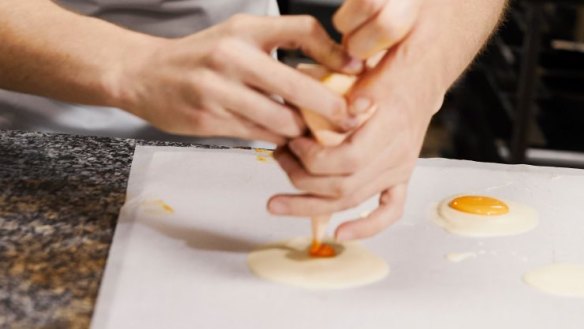
Stick the tray with the egg whites in the fridge for a minute to set the chocolate while you fill a fresh ziplock bag or cone with the orange-coloured chocolate. Once the whites are firm, pipe a smaller amount of orange-coloured chocolate into the centre of the white to create the yolk. Repeat for all the egg whites, then return the tray to the fridge to set.
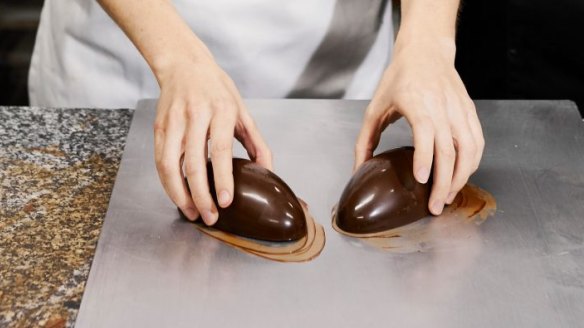
Step 4: Assembly
Place a flat baking tray in an oven set to 50 degrees. While the tray is heating, get the egg moulds out of the fridge and ease the chocolate out by placing a finger on the inside of the eggs at the tip and the base and lightly pulling. It helps if you twist the mould slightly beforehand, like you would with a tray of ice cubes, but providing the chocolate has been tempered properly they should lift out quite easily. Remove the chocolate gently and flip them so they're edge-side down.
Take the tray out of the oven and place it on your bench. Now, take two egg halves and place them edge side down onto the warm tray, moving them around slightly to lightly melt the edges. Press the edges together until they stick. You can now press the base of the egg gently against the warm tray to create a flat surface for the egg to stand up on, if you wish.
To attach the fried eggs, peel the eggs off the baking sheet and pipe a small amount of left-over tempered white chocolate onto the underside of the fried egg. Position it wherever you like on the Easter egg, and hold it in place until the chocolate has set and the fried egg has stuck. Note: Chocolate that has cooled to a slightly tacky consistency will stick better and faster, so make sure it's not too warm.
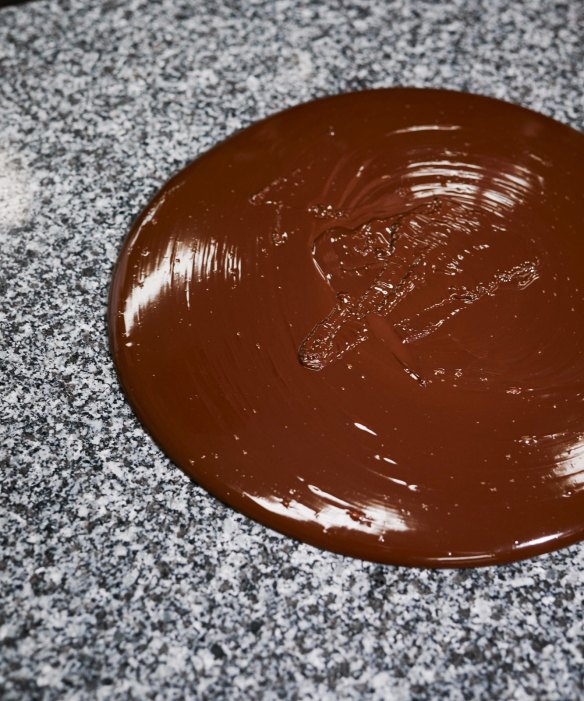
That's it! Once you have glued all your fried eggs onto your Easter egg, you are done. Your creation can be stored at room temperature, otherwise in the fridge if your room temperature is above 24 degrees.
Kirsten's tips:
■ Never use a glass bowl. Glass retains heat, so the bowl will slowly untemper your chocolate after you've finished heating it. Plastic is best – it will keep your chocolate at a nice ambient temperature.
■ Stir your chocolate – lots of movement is good, especially while it's cooling!
■ If you don't have a thermometer, dribble a bit of tempered chocolate on top of the rest of it – if it flows straight back into the chocolate it's too warm, but if it holds, it's just right.
■ Microwaves and hair dryers are your friend.
■ Don't use a liquid colour for your egg yolks – liquid will cause the chocolate to seize.
■ Tempering is easier with a bigger quantity of chocolate, but don't worry about waste: you can re-temper any leftover chocolate – just store it in opaque packaging at room temperature away from strong aromas until ready to use again.
Appears in these collections
The best recipes from Australia's leading chefs straight to your inbox.
Sign up